Z Magazine, October 2014
According to a long-dominant “mainstream” (corporate state) media narrative in the United States, Washington and the nation’s politics are crippled by terrible partisan “gridlock.” This reigning media meme says that the deadlock in Washington reflects deep “polarization” between “red” (older, whiter, more male, traditional, religious/Christian, rural, gun-owning, and Republican) and “blue” (less white, less culturally conservative, more female, more gay, younger, more urban, less Christian, and Democratic) “America.” This pervasive “great divide” among “We the people” makes it impossible for the nation’s elected officials to compromise to “get things done.” It’s a shame, this terrible standoff that mires the nation’s politics and policy in endless squabbling and logjam.
Not So Divided
There are, of course, real cultural and related political differences between, say, a predominantly Democratic and relatively gay- and atheist-friendly university town like Iowa City or Ann Arbor and a small predominantly Republican, gun-owning, and God-fearing town in rural Iowa or Michigan. It is, of course, all too true that the federal government and the nation seem hopelessly stalemated when it comes to achieving any number of policies that are urgently required in the name of basic social and democratic decency.
Still, the partisan polarization narrative is fundamentally incorrect and deceptive in three basic ways. The first problem is that U.S. citizens are nowhere nearly as divided along “Red” and “Blue” lines as media and political elites tell us. A recent study by the Program for Public Consultation (PPC) analyzed public polling data on a large number of policy proposals. The researchers examined answers to 388 questions from 24 major surveys conducted between 2008 and 2013. The polls chosen were selected because they included data about the state or district where each respondent lived, which could then be identified as primarily liberal (“blue”) or conservative (“red”).
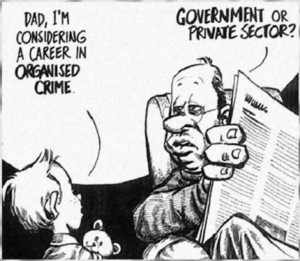 The researchers find “remarkably little difference between the views of people who live in red (Republican) districts or states, and those who live in blue (Democratic) districts or states… Most people living in red districts/states disagreed with most people in blue districts/states on only four percent of the questions…. For a large majority of questions—69 percent—there were no statistically significant differences between the views in the red districts/states and the blue districts/states.” Entitled A Not So Divided America, the study “contradicts the conventional wisdom that the political gridlock between Democrats and Republicans in Congress arises from deep disagreements over policy among the general public.” The researchers conclude that something else must be driving polarization in Congress. They don’t identify the culprit, but imply strongly that big money business interests play the primary role (PPC, A Not So Divided America, July 2014).
The researchers find “remarkably little difference between the views of people who live in red (Republican) districts or states, and those who live in blue (Democratic) districts or states… Most people living in red districts/states disagreed with most people in blue districts/states on only four percent of the questions…. For a large majority of questions—69 percent—there were no statistically significant differences between the views in the red districts/states and the blue districts/states.” Entitled A Not So Divided America, the study “contradicts the conventional wisdom that the political gridlock between Democrats and Republicans in Congress arises from deep disagreements over policy among the general public.” The researchers conclude that something else must be driving polarization in Congress. They don’t identify the culprit, but imply strongly that big money business interests play the primary role (PPC, A Not So Divided America, July 2014).
In that regard, it is interesting to look at some of the policy issues where PPC researchers found no statistically significant difference between residents of “red” and “blue” districts and states:
- Abortion should be legal in some cases. Agreement expressed by 73.9 percent of respondents in “Red America” (RA) and 77.8 percent in “Blue America” (BA). Difference: 3.9
- Favor background checks for all gun purchases: 79 percent in RA and 80.7 percent in BA. Difference: 1.0
- Gays and lesbians should be able to be hired as high school teachers. Agreement expressed by 66.8 percent in RA and 70.1 in BA. Difference: 3.3
- Government has a responsibility to stop employers from discriminating by race and ethnicity. Agreement expressed by 67.3 percent in RA and 70.8 percent in BA. Difference: 3.5
- Government should work to prevent discrimination against women. Agreement expressed by 80.7 percent in RA and 83.5 percent in BA. Difference: 2.8
- Health care is a right and not a privilege: agreement from 62.3 percent in RA and 62.9 percent in BA. Difference: 0.6
- Government needs to take major steps to reform health care: supported by 66.8 percent in RA and 68.8 percent in BA. Difference: 2.0
- Government should provide a public health insurance option that would compete with private insurance plans: supported by 54.7 percent in RA and 59.2 percent in BA. Difference: 4.5
- Government should increase spending on Social Security: Supported by 53.7 percent in RA and 55.1 percent in BA. Difference: 1.4
- Raise the cap on earnings taxed for the Social Security payroll tax: supported by 84.4 percent in RA and 83.5 percent in BA. Difference: 0.9
- Increase taxes on individual incomes between $200,000 and $500,000: supported by 66.7 percent in RA and 63.7 percent in BA. Difference: 3.0
- Increase taxes on individual incomes between $500,000 and $1 million: 70.5 percent in RA and 64.6 in BA. Difference: 5.9
- Government prohibition of public sector unions’ right to collective bargaining: opposed by 54.5 percent in RA and by 56.4 percent in BA. Difference: 1.9
- Continuation of the National Labor Relations Board as a government entity: supported by 61 percent in RA and 64.6 percent in BA. Difference: 3.5
- The government should increase spending on education: agreement expressed by 58.5 percent in RA and 59.3 percent in BA. Difference: 0.8
- Favor cutting military spending to reduce the deficit: 67.6 percent in RA; 67.8 percent in BA. Difference: 0.2
- Favor cutting spending on intelligence agencies: 57 RA; 58.8 BA. Difference: 1.7
- The U.S. should cut federal subsidies to agricultural corporations and large farms: 65.8 RA; 68.3BA. Difference: 2.5
- Oppose a “free trade” agreement with China: in 56.5 RA; 56 percent BA. Difference: 0.5
- Oppose a “free trade” agreement with Columbia: 58.9 RA; 57.3 BA. Difference: 1.6
- Oppose a “free trade” agreement with South Korea: 52 RA; 50 BA. Difference: 2.0
Besides showing that red and blue districts are much closer on basic policy issues than is commonly claimed, these findings also suggest that the population as a whole is well to the left of its supposed political representatives—even in Republican strongholds. Numerous social scientists and informed political commentators have noted in recent years that majority public opinion in the U.S. stands well to the progressive, social-democratic left of both of the nation’s two dominant and corporate-captive political organizations. This appears to be the case even in the nation’s right-represented red zones.
The Donor Class v. The Rest of Us
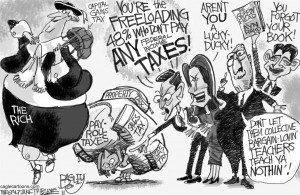 A second and related problem with dominant media’s “partisan polarization” and “gridlock” narrative is that it misses the much greater and actual polarization existing between the majority progressive and non-affluent U.S. citizenry on one hand and wealthy U.S. citizens on the other. A 2011 survey funded by the Russell Sage Foundation and conducted by NORC found substantial policy differences between the top 1 percent of U.S. wealth-holders and the U.S. general public when it came to jobs, poverty, income, and welfare.
A second and related problem with dominant media’s “partisan polarization” and “gridlock” narrative is that it misses the much greater and actual polarization existing between the majority progressive and non-affluent U.S. citizenry on one hand and wealthy U.S. citizens on the other. A 2011 survey funded by the Russell Sage Foundation and conducted by NORC found substantial policy differences between the top 1 percent of U.S. wealth-holders and the U.S. general public when it came to jobs, poverty, income, and welfare.
In addition, the Center for American Progress (CAP) has found that 73 percent of U.S. citizens “earning” less than $20,000 (“low income Americans”) think that the gap between the rich and poor should be reduced. That opinion is shared by 54 percent of U.S. citizens earning more than $100,000 (“affluent Americans”), making for a difference of 19 points. In a similar vein, fully 84 percent of “low income Americans” felt the federal government ought to guarantee affordable health care coverage to every U.S. resident, compared to 59 percent of “affluent Americans”—a difference of 25 percent. CAP found that just over a third (36 percent) of affluent respondents agreed that “labor unions play a positive role in our economy.” More than half (55 percent) of “low income Americans” agree with that statement (see David Callahan and J. Mijin Cha, “Stacked Deck: How the Dominance of Politics by the Affluent and Business Undermines Economic Mobility in America,” New York: Demos, February 2013).
The U.S. populace has long told pollsters that the government’s main priority ought to be job creation, not deficit reduction. As Demos magazine noted in December 2012, “the public remain[s] focused on jobs and the economy over the deficit by two-to-one margins or more.” Surveys undertaken after Obama’s re-election found that “49 percent thought the election was a mandate for job creation while only 22 percent said that the President’s mandate was for deficit reduction.” NBC’s exit poll showed that “only 15 percent of voters thought the deficit was the biggest problem facing the country.” A majority supported “spending money to invest in infrastructure/public sector hiring, like teachers and firepeople, versus cutting to reduce the deficit.”
Affluent Americans do not agree. As Demos writer J. Mijin Cha explained, “The donor class—the segment of the population that donates to political campaigns—is disproportionately comprised of affluent Americans.” This “donor class” (predominantly from households in the top income quintile), “does not prioritize policies to create jobs and economic growth.” It is “twice as likely to name the budget deficit as the most important issue in deciding how they would vote than middle- or lower-income respondents.” It overwhelmingly rejects federal government action to help create jobs (J. Mijin Cha, “Why is Washington Reducing the Deficit Instead of Creating Jobs?” Demos, December 7, 2012).
And here, as on most, if not, all major key political-economic issues in the current neoliberal New Gilded Age, the donor class has won the policy argument, in abject defiance of majority sentiments. “Austerity dominates the current political debate” in ways that reflect “the influence of money in our political system…as evidenced in how well the interests and priorities of the affluent class are represented in Congressional action—even when they run counter to the wishes of most Americans” (Cha, “Why is Washington….”).
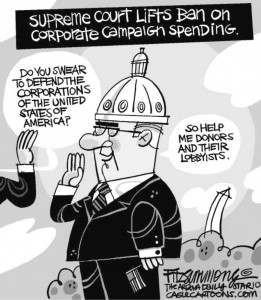 There are many other examples. On issue after issue, public opinion is irrelevant (or very close to it) in the realm of serious politics and policy, controlled by the nation’s “unelected dictatorship of money” (Edward S. Herman and David Peterson’s phrase). Take health care coverage. Most Americans have long favored a single-payer national health insurance plan on the Canadian model. Their preference for such substantive, seriously social-democratic health reform has found no representation among the corporate- and Wall Street-captive lobbyists and politicians who pushed for big business-friendly versions of “health insurance reform. The version that finally passed in 2009, the so-called Affordable Health Care Act (ACA), is a monument to corporate and financial plutocracy. Last October, Robert Lenzner, a veteran New York investment banker and a staff writer at no less capitalist a journal than Forbes, expressed his hope that the ACA will someday be reformed “for the benefit of the 300 million, not just the millions of lucky shareholders who may have understood the ramification of ObamaCare, which was to multiply the profits of five giant insurance companies, just as the major bank oligopoly was rewarded by the federal bailouts and Fed monetary policy.”
There are many other examples. On issue after issue, public opinion is irrelevant (or very close to it) in the realm of serious politics and policy, controlled by the nation’s “unelected dictatorship of money” (Edward S. Herman and David Peterson’s phrase). Take health care coverage. Most Americans have long favored a single-payer national health insurance plan on the Canadian model. Their preference for such substantive, seriously social-democratic health reform has found no representation among the corporate- and Wall Street-captive lobbyists and politicians who pushed for big business-friendly versions of “health insurance reform. The version that finally passed in 2009, the so-called Affordable Health Care Act (ACA), is a monument to corporate and financial plutocracy. Last October, Robert Lenzner, a veteran New York investment banker and a staff writer at no less capitalist a journal than Forbes, expressed his hope that the ACA will someday be reformed “for the benefit of the 300 million, not just the millions of lucky shareholders who may have understood the ramification of ObamaCare, which was to multiply the profits of five giant insurance companies, just as the major bank oligopoly was rewarded by the federal bailouts and Fed monetary policy.”
The U.S. could eliminate its much-bemoaned fiscal deficit by replacing the nation’s privatized, corporate-run and largely employment-based health insurance system with a universal public model similar to what exists in other industrial nations—with a system that would cut health costs in half, yet deliver superior outcomes. But that’s irrelevant thanks to the current “democracy deficit” imposed by the reigning “plutonomy,” wherein “the financial institutions and Big Pharma are far too powerful for such options even to be considered” (Noam Chomsky, “America in Decline,” Truthout, August 5, 2011).
U.S. “No Longer an Actual Democracy”
Which brings us to the third major problem with the partisan polarization and gridlock narrative: its failure to distinguish adequately between the rich and the rest of us when it comes to who does and doesn’t get what they want from government. Washington and the 50 U.S. state capitals are far more paralyzed and deadlocked when it comes to meeting the needs of “the 99 percent” than when it’s about serving the donor class.
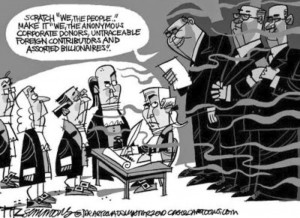 You don’t have to be a Marxist, left-anarchist, or other kind of “dangerous radical” to note that popular governance or democracy has been trumped by oligarchy and plutocracy in the contemporary United States. In a study released last April and scheduled for publication in Perspectives on Politics this fall, leading mainstream political scientists Martin Gilens (Princeton) and Benjamin Page (Northwestern) report that U.S. democracy no longer exists. Over the past few decades, Gilens and Page determined that the U.S. political system has become “an oligarchy,” where wealthy elites and their corporations “rule,” wielding wildly disproportionate power over national policy. Examining data from more than 1,800 different policy initiatives from 1981 to 2002, they find that wealthy and well-connected elites consistently steer the direction of the country, regardless of or even against the will of the U.S. majority. “The central point that emerges from our research is that economic elites and organized groups representing business interests have substantial independent impacts on U.S. government policy,” Gilens and Page write, “while mass-based interest groups and average citizens have little or no independent influence” (M. Gilens and B. Page, “Testing Theories of American Politics: Elites, Interest Groups, and Average Citizens,” April 9, 2014, www.google.com).
You don’t have to be a Marxist, left-anarchist, or other kind of “dangerous radical” to note that popular governance or democracy has been trumped by oligarchy and plutocracy in the contemporary United States. In a study released last April and scheduled for publication in Perspectives on Politics this fall, leading mainstream political scientists Martin Gilens (Princeton) and Benjamin Page (Northwestern) report that U.S. democracy no longer exists. Over the past few decades, Gilens and Page determined that the U.S. political system has become “an oligarchy,” where wealthy elites and their corporations “rule,” wielding wildly disproportionate power over national policy. Examining data from more than 1,800 different policy initiatives from 1981 to 2002, they find that wealthy and well-connected elites consistently steer the direction of the country, regardless of or even against the will of the U.S. majority. “The central point that emerges from our research is that economic elites and organized groups representing business interests have substantial independent impacts on U.S. government policy,” Gilens and Page write, “while mass-based interest groups and average citizens have little or no independent influence” (M. Gilens and B. Page, “Testing Theories of American Politics: Elites, Interest Groups, and Average Citizens,” April 9, 2014, www.google.com).
A story about Gilens and Page’s study in the liberal online journal Talking Points Memo (TPM) last April bears an interesting title: “Princeton Study: U.S. No Longer an Actual Democracy.” The story contained a link to an interview with Gilens in which he explained that “contrary to what decades of political science research might lead you to believe, ordinary citizens have virtually no influence over what their government does in the United States. And economic elites and interest groups, especially those representing business, have a substantial degree of influence.”
The leading Princeton economist, and former Federal Reserve Chair Alan S. Blinder, appears to agree. “Sadly, within our political system so dominated by money, ‘equal political rights’ is a cruel deception…political and economic inequality reinforce one another, creating a well-known vicious circle” wrote Blinder in the opinion pages of the Wall Street Journal last August (A. Blinder, “The Supply-Side case for Government Redistribution,” WSJ, August 14, 2014).
Such is the harsh reality of the U.S. “existing capitalist democracy”—what Noam Chomsky calls “RECD, pronounced as ‘wrecked’” (Noam Chomsky, “Can Civilization Survive Capitalism?” Truthout, March 5, 2013).
U.S. “oligarchy” is nothing new to the last few years. Plutocracy has been accelerating for decades and so cannot simply be attributed to recent Supreme Court decisions allowing more money in politics, such as Citizens United (2010) or McCutcheon v. FEC. At the same time, the problem is no less evident when Democrats hold ostensible power than when Republicans are in nominal charge. The plutocracy is bipartisan, consistent with Upton Sinclair’s 1904 description of the two dominant U.S. political parties as “two wings of the same bird of prey.” Elites in Washington know very well that partisan “ideological warfare” and “gridlock” is a game played on the nation by the economic power elite. In his bestselling book, This Town: Two Parties and a Funeral Plus Plenty of Valet Parking in America’s Gilded Capital (New York: Penguin, 2013), the New York Times Magazine’s chief national correspondent Mark Leibovich—a self-confessed member of “the [Washington DC] club” (again, no radical)—told some candid truths from the belly of beast. By Leibovich’s account, Washington is a bipartisan “gold rush”—a “crucible of easy wealth” wherein political officeholders, lobbyists, consultants, public relations specialists, media personalities, socialites, and top staff from both of the two dominant U.S. political parties are part of the same incestuous and “permanent” ruling “class of insiders.” These insiders “becomes a determinedly bipartisan team when there is money to be made.” The nation’s capital is an “inbred company town where party differences are easily subsumed by membership in The Club.”
“Getting rich,” Leibovich writes, “has become the great bipartisan ideal: No Democrats and Republicans in Washington anymore, goes the maxim, only millionaires. The ultimate Green Party. You still hear the term public service thrown around, but often with irony and full knowledge that self-service is now the real insider play.”
Much of what is presented by corporate media as “Washington’s dysfunction”—gridlock, hyper-partisanship, the failure of Republicans and Democrats “to work together”—is quite purposeful and functional for elites. Washington has become “more concerned with economics than politics,” Leibovich notes, and “much of the Washington’s economy—lobbying, political consulting, and cable news—is predicated on the perpetuation of conflict, not the resolution of problems.” It is outward partisan and personality conflict, after all, that:
- Attracts viewers and readers
- Keeps cash flowing into Super PACs
- Sells political advertisements
- Creates political careers that former public office-holders turn into more lucrative careers
in the private sector, “monetizing their government service”
by taking lucrative positions as lobbyists, consultants, and media talking heads.
Politics as partisan and ideological theater is more materially rewarding than “doing the people’s work” and serving the common good. All the partisan, outwardly “ideological” shouting over the airwaves and across the cable news spectrum, Leibovich notes, is “winking performance art” meant to hide the “reality” that, “off-air, everyone in Washington is joined in a multilateral conga line of potential business partners.” Behind the scenes, smart Washington operatives of both parties are figuring out how to profit from “the continued and sweaty orgy raging between corporate and political enterprise” and the ongoing “romance between Washington and Wall Street.” The “partisan” and “ideological” bickering that dominant media point to as the source of “Washington’s [constantly bemoaned] dysfunction” (and as proof of “big government’s” inherent failures) is all part of the big capitalist hustle. “The city, far from being hopelessly divided, is, in fact, hopelessly interconnected” by the ‘sweaty,’ cross-party contest for gain, fame, and pleasure…for more. ”
The Ultimate Owner of the Deep State
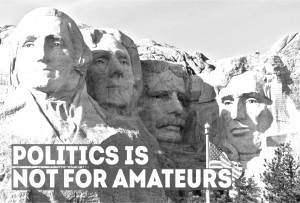 In a widely circulated essay published on Bill Moyers.com last spring, former Washington political operative Mike Lofgren noted that the nation’s corporatist “Deep State” was running very smoothly beneath all the noise and news of partisan deadlock at the surface parliamentary level. While elected officials and other politicians caught up in the Wall Street-funded “marionette theater” of Washington’s highly visible partisan politics are typically said to be engaged in “ideological warfare,” Deep State operatives like David Patraeus, Lawrence Summers, Robert Rubin, and (former Bush and Obama Defense Secretary) Robert Gates are “deeply dyed in the hue of the official ideology of the governing class, an ideology that is neither specifically Democrat nor Republican.” That ideology combines “The Washington Consensus: financialization, out-sourcing, privatization, deregulation, and the commodifying of labor, with 21st-century American Exceptionalism: the right and duty of the United States to meddle in every region of the world with coercive diplomacy and boots on the ground and to ignore painfully won international norms of civilized behavior.”
In a widely circulated essay published on Bill Moyers.com last spring, former Washington political operative Mike Lofgren noted that the nation’s corporatist “Deep State” was running very smoothly beneath all the noise and news of partisan deadlock at the surface parliamentary level. While elected officials and other politicians caught up in the Wall Street-funded “marionette theater” of Washington’s highly visible partisan politics are typically said to be engaged in “ideological warfare,” Deep State operatives like David Patraeus, Lawrence Summers, Robert Rubin, and (former Bush and Obama Defense Secretary) Robert Gates are “deeply dyed in the hue of the official ideology of the governing class, an ideology that is neither specifically Democrat nor Republican.” That ideology combines “The Washington Consensus: financialization, out-sourcing, privatization, deregulation, and the commodifying of labor, with 21st-century American Exceptionalism: the right and duty of the United States to meddle in every region of the world with coercive diplomacy and boots on the ground and to ignore painfully won international norms of civilized behavior.”
The corporatist Deep State runs quite smoothly on behalf of the nation’s elite, Lofgren reported. On one hand, the nation’s bridges, railroads, highways, and electronic grid are rotting away. Vast swaths of the populace have been rendered permanently jobless and poor. And the social safety net is torn to shreds along with public infrastructure. Cities have gone bankrupt across the nation, especially in the Midwestern rustbelt, with no relief. The “ordinary, visible parliamentary institutions of self-government” have “decline[ed] to the status of a banana republic amid the gradual collapse of public infrastructure,” Lofrgren observed. On the other hand, the government under the red Bush and the blue Obama manages somehow to spend trillions of taxpayer dollars on a massive global and domestic empire of Orwellian electronic surveillance, repeated foreign interference, invasion, and occupation, drone warfare, and secret prisons—not to mention (Lofgren did not) the colossal bailout of the “too-big-to-fail” Wall Street firms, whose top managers stand above the law even after plunging millions into poverty and even as the federal government regularly imposes life-without-parole sentences on alleged small time drug-dealers.
Finance capital is the biggest player of all. “It is not too much,” Lofgren wrote, “to say that Wall Street may be the ultimate owner of the Deep State and its strategies, if for no other reason than that it has the money to reward government operatives with a second career that is lucrative beyond the dreams of avarice—certainly beyond the dreams of a salaried government employee” (M. Lofgren, “Anatomy of the Deep State,” Moyers & Company, February 21, 2014).
The mild-mannered Lofgren is no dangerous radical. He retired 3 years ago from a 28-year career as a top Republican Congressional staffer with significant high-level expertise in national security matters.
You don’t have to take it from a “radical leftist.” Elite insiders like Leibovich, mainstream Ivy League analysts like Martin Gilens and Alan Blinder (also something of an insider), and Beltway defectors like Mike Lofgren can tell us a lot of what we need to know about “RECD” in the U.S. The oligarchic nature of U.S. politics and policy today is an open secret. The harsh plutocratic reality is certainly well understood by many of the elite media and political operatives who disseminate and cash in on the reigning narrative of a deeply divided populace paralyzed by partisan ideological warfare.
